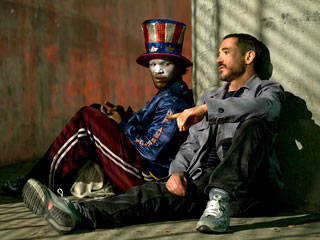Poet Maya Angelou met comedian Dave Chappelle on Sundance Channel’s show
Iconoclasts.
Dave Chapelle asked her about growing up in the civil rights movement and what it meant to have experienced such intense marginalization based solely on the color of her skin and if it ever made her her angry.
“Absolutely,” she said quite simply. “But what you do with anger is you paint it, and you speak
it, and you dance it, and you sing it, and you write it, and you sculpt it.”
The act of drowning one’s anger and hurt in art was never more real to the man, Nathaniel Anthony Ayers, Jr., played by Jaime Foxx in this season’s Oscar-worthy film, The Soloist.
This story was inspired by a series of real-life columns written by Los Angeles Times columnist Steve Lopez, who wrote about the plight of a homeless, schizophrenic musician, Ayers, (which eventually was chronicled in Lopez's book, "The Soloist."
Lopez first discovers Ayers living in L.A.’s Skid Row, and after piecing together fragments of Nathaniel’s ramblings then corroborating the details, he learns that Nathaniel was once a musical prodigy and trained on the cello at the Juilliard School of Music.
The intensely descriptive film takes us on flashbacks to Ayers’ childhood growing up in a single parent household where upstairs served as mom’s convertible beauty shop and the basement - his bedroom and own personal musical lair where low, sonorous chords of the cello would fill the air for hours and hours on end.
From an early age, he gave himself over so profoundly to the cello’s sweet sounds, more intensely and far more lovingly than an addict would to his substance.
And, instead of an addict’s track marks, young Nathaniel sketched pen
marks on his forearm indicative of his four-stringed instrument. Then, it was
easy to channel his anguish and pain in
While Nathaniel often used music to self-medicate, its side effects were not all that different from a crack fiend’s. Fear, paranoia, and the onslaught of impending voices.
The more he surrendered to the study, training and consumption of the art form, the madder he became. Yet, what genius didn’t suffer from a quirk or mental illness? Edgar Allen Poe, Winston Churchill, Carly Simon were all among the myriad of geniuses who went mad.
For decades, scientists have
known that eminently creative individuals have a much higher rate of manic
depression, or bipolar disorder, than does the general population.
But, in
recent years, using personality and temperament tests, Terence Ketter, M.D., of
Stanford University found healthy artists to be more similar in personality to
individuals with manic depression than to healthy people in the general
population.
The shared traits between unusually creative people and the mentally ill include hostility and introversion found in scientists and impulsivity, lack of consciousness and emotional sensitivity found in artists.
Foxx delivers a most convincing performance of capturing real-life Nathaniel’s aloofness and frequent regression to internal fantasy-like sequences. Although extremely deferential in his interactions with people, there were moments of intense rage and episodic spikes in violence for Nathaniel that wiped Foxx right out of the frame. And, there we saw only Nathaniel.

In the end, as Nathaniel’s only friend, a unique process of healing ensues as Nathaniel finds it easier to re-integrate into the real world because he has at least one connection to fall back on.
As the story moves on, the notion of “God” is introduced. Nathaniel deems his relationship with Lopez as one that parallels man and Messiah.
He interprets Lopez as the divine being that gives good gifts, rescues him from obscurity and restores a semblance of manhood. Lopez, of course, eschews this responsibility as he does his own familial obligations.
As clouded as this idea may be,
Nathaniel isn’t far removed from reality in his judgment of the situation.
Human beings do serve as God’s hands and feet to bring hope to
The mere act of befriending the homeless or caring for a person with a mental illness can be the very act that starts them off on a path of healing.
And the truth is…you may, in the process, begin to view your own insecurities and insane complexities that will provoke you to adopt an attitude of less judgment and more tolerance to know we are all in need of a Savior.


